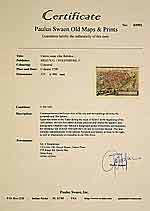Lot #: 33680
Parma [on sheet with] Sena [and] Panhormus, Palermo vulgariter, ... [and] Drepanum (Trapani) |
||||||||||||||||||||
|
||||||||||||||||||||
|
|
||||||||||||||||||||
|
Selling price: $400
Sold in 2019 Join our News Letter to get informed when a similar item comes available. Do you have an example you would like to sell? |
Views: 190
|
|||||||||||||||||||
Description
Four very desirable and early town-plans of Parma, Siena, Palermo and Trapani.
"PARMA : "Parma is shown from an elevated viewpoint. The city is divided in half by the Parma: on the right-hand side the eye is struck by the imposing domed Romanesque cathedral of the Ascension of the Virgin with the Baptistery behind it. Behind the apse of the cathedral stands the church of San Giovanni Evangelista, whose cupola is decorated inside with the fresco cycle of the Vision of St John of Patmos by Correggio.
In the first half of the 15th century Parma formed part of the Papal States, until the Farnese pope Paul III created the Duchy of Parma in 1545, after which is was ruled by the Farnese dynasty until 1731. In the right-hand foreground is the Palazzo Ducale, remodeled in 1561 for Ottavio Farnese." . (Taschen, Braun and Hogenberg, p.118.)
SIENA : "Siena is seen from afar, whereby its skyline of family towers gives an immediate impression of the self-confidence of a populace that found itself in artistic and economic competition with Florence and politically dependent upon Milan or the Emperor.
Siena cathedral (right) with its black and white marble is an outstanding example of the Gothic style in central Italy. Opposite lies the pilgrims' hospice, Santa Maria della Scala, founded around 1000, containing important 15th-century frescos. Secular power is represented by the Palazzo Pubblico with its all-overshadowing Torre del Mangia. In 1557 Siena became part of the Grand Duchy of Tuscany under Cosimo I de' Medici. The Palio di Siena, a horse race between the city wards, takes place on the Piazza del Campo in July and August. .". (Taschen, Braun and Hogenberg, p.118.)
PALERMO : "Rising above the harbour is the massive cathedral of Maria Santissima Assunta, built in the Norman-Arab style in the 12th century and continually expanded from the 14th to the 16th century. The plate records its appearance in the mid-16th century with four corner towers and with Gothic spires. The crypt contains the tombs of the Hohenstaufen emperors Henry VI and Frederick II. Within Sicily's eventful history, the Hohenstaufens were responsible for a flowering of the arts in Palermo from 1194. The French occupying forces and Sicilian Vespers mentioned in the cartouche refer to the bloody uprising by the Sicilians against the rule of Charles I of Anjou, whom the Pope had appointed King of Sicily in 1266.". (Taschen, Braun and Hogenberg, p.118.)
TRAPANI : "on the west coast of Sicily, is shown from the sea, whereby the curved natural harbour explains the name of the town (Gr. Drepanum, "sickle"). A strategic base for the Carthaginians in the First Punic War, in 241 BC Trapani was conquered by the Romans. With the arrival of the Arabs in the 9th century, the town saw an economic upswing.
In 1266 it came under the rule of Charles I of Anjou and then passed to the Kingdom of Aragon. In the 15th century it rose to become western Sicily's most important port, a position it has retained right up to the present." . (Taschen, Braun and Hogenberg, p.118.)
From volume one of the greatest publication in this genre!. The Civitates was compiled and written by George Braun, Canon of Cologne Cathedral. Braun gathered together vast amounts of information and draft plans to produce over 500 city views/maps published in six parts between 1572 and 1617. Most of these engravings were made by Simon Novellanus and Frans Hogenberg, many after drawings by Joris Hoefnagel.
Read more about the Civitates Orbis.
Reference: Koeman (1967-70) B & H 1-5, NMM III, i, 459 (1573-1618 ed.), Introduction', in: G. Braun and F. Hogenberg, Civitates orbis terrarum (Amsterdam: 1965). (2)
"PARMA : "Parma is shown from an elevated viewpoint. The city is divided in half by the Parma: on the right-hand side the eye is struck by the imposing domed Romanesque cathedral of the Ascension of the Virgin with the Baptistery behind it. Behind the apse of the cathedral stands the church of San Giovanni Evangelista, whose cupola is decorated inside with the fresco cycle of the Vision of St John of Patmos by Correggio.
In the first half of the 15th century Parma formed part of the Papal States, until the Farnese pope Paul III created the Duchy of Parma in 1545, after which is was ruled by the Farnese dynasty until 1731. In the right-hand foreground is the Palazzo Ducale, remodeled in 1561 for Ottavio Farnese." . (Taschen, Braun and Hogenberg, p.118.)
SIENA : "Siena is seen from afar, whereby its skyline of family towers gives an immediate impression of the self-confidence of a populace that found itself in artistic and economic competition with Florence and politically dependent upon Milan or the Emperor.
Siena cathedral (right) with its black and white marble is an outstanding example of the Gothic style in central Italy. Opposite lies the pilgrims' hospice, Santa Maria della Scala, founded around 1000, containing important 15th-century frescos. Secular power is represented by the Palazzo Pubblico with its all-overshadowing Torre del Mangia. In 1557 Siena became part of the Grand Duchy of Tuscany under Cosimo I de' Medici. The Palio di Siena, a horse race between the city wards, takes place on the Piazza del Campo in July and August. .". (Taschen, Braun and Hogenberg, p.118.)
PALERMO : "Rising above the harbour is the massive cathedral of Maria Santissima Assunta, built in the Norman-Arab style in the 12th century and continually expanded from the 14th to the 16th century. The plate records its appearance in the mid-16th century with four corner towers and with Gothic spires. The crypt contains the tombs of the Hohenstaufen emperors Henry VI and Frederick II. Within Sicily's eventful history, the Hohenstaufens were responsible for a flowering of the arts in Palermo from 1194. The French occupying forces and Sicilian Vespers mentioned in the cartouche refer to the bloody uprising by the Sicilians against the rule of Charles I of Anjou, whom the Pope had appointed King of Sicily in 1266.". (Taschen, Braun and Hogenberg, p.118.)
TRAPANI : "on the west coast of Sicily, is shown from the sea, whereby the curved natural harbour explains the name of the town (Gr. Drepanum, "sickle"). A strategic base for the Carthaginians in the First Punic War, in 241 BC Trapani was conquered by the Romans. With the arrival of the Arabs in the 9th century, the town saw an economic upswing.
In 1266 it came under the rule of Charles I of Anjou and then passed to the Kingdom of Aragon. In the 15th century it rose to become western Sicily's most important port, a position it has retained right up to the present." . (Taschen, Braun and Hogenberg, p.118.)
From volume one of the greatest publication in this genre!. The Civitates was compiled and written by George Braun, Canon of Cologne Cathedral. Braun gathered together vast amounts of information and draft plans to produce over 500 city views/maps published in six parts between 1572 and 1617. Most of these engravings were made by Simon Novellanus and Frans Hogenberg, many after drawings by Joris Hoefnagel.
Read more about the Civitates Orbis.
Reference: Koeman (1967-70) B & H 1-5, NMM III, i, 459 (1573-1618 ed.), Introduction', in: G. Braun and F. Hogenberg, Civitates orbis terrarum (Amsterdam: 1965). (2)
FAQ - Guarantee - Shipping
In our BUY-or-BID sale, you never pay more than the Buy price.
To buy or bid in this Buy-or-Bid sale you must register with us. It is free, and we automatically update you about future auctions.During the Buy-or-Bid sale, you can buy or bid on 600- 900 antique, rare maps, town views, old master prints, decorative prints, atlases, posters and Medieval manuscripts.
- We show the "Bid & Ask spread" (to define the gap between the minimum accepted bid and Buy price.)
- Items that have received bids within the BidAsk spread are sold at the highest bid at closing.
- Once the Buy price is paid, the sale for this item has closed.
Do you have a similar item you want to sell ?
Interested in selling your antique maps, original prints, vintage posters, or historic Ephemera?Let us help you!
Start your consignment today. We provide estimates free of charge from photographs sent via the Internet. Fill out our online estimation form, and we will contact you with an estimate.
Learn more about consigning at RarePaperSales.com
Guarantee
 We warranty the authenticity of each lot offered in our sale. There is no time limitation to this guarantee.
We warranty the authenticity of each lot offered in our sale. There is no time limitation to this guarantee.- Defects in lots have been carefully noted.
- If there are no remarks regarding splits, tears, discoloration, etc., there are no issues to be found for the item!
- All items are carefully and personally examined before being packed "in-house" and shipped by UPS, USPS, DHL or registered mail.
- We do not sell reproductions.
- A certificate of authenticity is provided for each acquired item and can be downloaded from your invoice page.
- Certificates can be found in the Invoice and Certificates center.
Shipping
Maps are shipped in solid tubes or flat between solid cardboard. Fully insured, signature required, and with online tracking. Shortly after shipment, you will get the tracking number by email.The standard is that we ship items by UPS or DHL for European destinations, and a flat shipping fee is added to each shipment. It is a one-time fee even if you buy multiple items. This fee covers shipping and insurance (up to the invoice amount) to:
- North America, Canada, Europe $ 30
- Asia $ 40
- For South America, Mauritius, Africa and Australia a shipping fee of $ 50 will be charged.
We charge only a one-time shipping fee if you have won 2 or more items.

Hold Shipment Service
Rare Paper Sales allows you to put your shipping on hold at no additional charge. This can be incredibly convenient for people who want to buy several items at different auctions and ship them together. The service is free, and you pay only one shipment fee.
Contact us if you want to use the Hold Service.
High-Resolution Digital Image Download |
|
|
RarePaperSales maintains an archive of most of our high-resolution rare maps, prints, posters and medieval manuscript scans. We make them freely available for download and study. Read more about free image download |
![Old map image download for Parma [on sheet with] Sena [and] Panhormus, Palermo vulgariter, ... [and] Drepanum (Trapani)](/uploads/cache/33680-500x500.jpg)